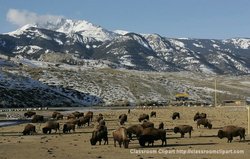American Bison
|
|
| American Bison Conservation status: Lower risk | ||||||||||||||||
|---|---|---|---|---|---|---|---|---|---|---|---|---|---|---|---|---|
 Alternate image—Bison young | ||||||||||||||||
| Scientific classification | ||||||||||||||||
| ||||||||||||||||
| Binomial name | ||||||||||||||||
| Bison bison Linnaeus, 1758 |
The American Bison (Bison bison), also called Buffalo, is a bovine mammal that is the largest terrestrial mammal in North America. The bison inhabited Great Plains of the United States and Canada in massive herds, ranging from the Great Slave Lake in Canada's far north to Mexico in the south, and from eastern Oregon almost to the Atlantic Ocean. Its two subspecies are the Plains Bison (Bison bison bison), distingushed by its flat back, and the Wood Bison (Bison bison athabascae), distingushed by its large humped back.
Bison have a shaggy, dark brown winter coat, and a lighter brown (and lighter weight) summer coat. Bison can reach over 2 m (6 feet) tall, 3 m (10 ft) long and weigh over 900 kg (2,000 pounds). The heads and forequarters are massive, and both sexes have short, curved horns, which they use in fighting for status within the herd and defense. Bison mate in August and September; a single reddish-brown calf is born the following spring, and nurses for a year. Bison are mature at three years of age, and have a life expectancy of 18–22 years.
Their mating habits are polygynous: Dominant bulls maintain a small harem of females for mating. Individual bulls "tend" females until allowed to mate, following them around and chasing away rival males.
Homosexuality— including courtship and mounting between bulls—is common among bison. The Mandan nation Okipa festival concludes with a ceremonial enactment of this behavior, to "ensure the return of the buffalo in the coming season." (Bruce Bagemihl, Whole Earth, 2000) See Homosexuality in animals
Calves are born with a light brown fur coat which darkens as the animal matures. One very rare condition results in the white buffalo, where the calf has an entirely white coat. It is not to be confused with albino, since pigment still exists in the skin, hair, and eyes, and the animals will end up with a brown-colored coat as they mature. White buffalo are considered sacred by many Native Americans.
Bison were central to the lifestyle of Native Americans of the Great Plains. Before the introduction of horses, buffalo were herded into large chutes made of rocks and willow branches and then stampeded over cliffs. These buffalo jumps are found in several places in the US and Canada.
Bison were hunted almost to extinction in the 19th century; as few as 750 bison existed in 1890. The Bronx Zoo maintained a remnant herd, some of which was transported in the early 20th century to Yellowstone National Park to bolster its faltering indigenous herd (which poaching had reduced to a few dozen animals), joining with transplants from other wildlife preserves. Some of these came from Charles Goodnight's ranch in the Texas Panhandle. A variety of privately-owned herds have also been established, starting from this population. The current American Bison population has been growing rapidly and is estimated at 350,000, but this is compared to an estimated 60–100 million during the end of the pre-Columbian era.
Hunters were paid by large railroad concerns to destroy entire herds for several reasons:
- The herds formed the basis of the economies of local Plains tribes of Native Americans.
- Herds of these large animals on tracks could damage locomotives when the trains failed to stop in time.
- Herds often took shelter in the artificial cuts formed by the grade of the track winding though hills and mountains in harsh winter conditions. This could hold up a train for days.
There is now a proposal known as Buffalo Commons to restore large parts of the drier portion of the Great Plains to native prairie grazed by bison. Proponents argue that current agricultural use of the shortgrass prairie is not sustainable, as indicated by periodic disasters such as the Dust Bowl and continuing significant population loss over the last 60 years.
Bison are now raised for meat and hides. Over 250,000 of the 350,000 remaining bison are being raised for human consumption. Bison meat is lower in fat and cholesterol than beef which has led to the development of beefalo, a fertile cross-breed of bison and domestic cattle. Recent genetic studies of privately-owned herds of bison show that many of them include animals with genes from domestic cattle; there may be as few as 15,000 pure bison in the world. The numbers are uncertain because the tests so far used mitochondrial DNA analysis, and thus would miss cattle genes inherited in the male line; some of the hybrids look exactly like purebred bison.
The bison is a symbol of Manitoba, the Royal Canadian Mounted Police, the University of Colorado, Marshall University, and North Dakota State University, and was depicted on the reverse side of the U.S. "buffalo nickel" from 1913 to 1938. In 2005 the United States Mint coined a special issue nickel with a new depiction of the bison.
Clipart and Animal Pictures
- Clipart (https://classroomclipart.com/image/category/clipart.htm)
- Animal Clipart (https://classroomclipart.com/image/category/animal-clipart.htm)
- Animal Animated Clipart (https://classroomclipart.com/clipart/Animations/Animals.htm)
- Pictures of Animals (https://classroomclipart.com/image/category/animal-photos.htm)
- Amphibian Clip Art, Pictures and Photogaphs (https://classroomclipart.com/image/category/amphibian-clipart.htm)
- Farm Animal Clip Art, Pictures and Photographs (https://classroomclipart.com/image/category/farm-animal-clipart.htm)
- Mammal Clip Art, Pictures and Photographs (https://classroomclipart.com/image/category/mammal-clipart.htm)
- Marine Animal Clip Art, Pictures and Photographs (https://classroomclipart.com/image/category/marine-life-clipart.htm)
- Reptile Clip Art, Pictures and Photographs (https://classroomclipart.com/image/category/reptile-clipart.htm)
- Spider Clip Art, Pictures and Photographs (https://classroomclipart.com/image/category/spider-clipart.htm)
External links
- BisonCentral.com (http://www.bisoncentral.com/)
- Buffalo Field Campaign (http://www.buffalofieldcampaign.org/)
- Canadian Bison (http://www.canadiangeographic.ca/Magazine/jf05/indepth/)



